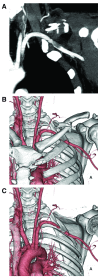Case Report: Urgent endovascular treatment of subclavian artery injury after blunt trauma
- PMID: 25717371
- PMCID: PMC4329670
- DOI: 10.12688/f1000research.5963.1
Case Report: Urgent endovascular treatment of subclavian artery injury after blunt trauma
Abstract
Subclavian arterial injury is rare and potentially life-threatening, particularly when it leads to arterial occlusion, causing limb ischemia, retrograde thromboembolization and cerebral infarction within hours after injury. Here we report a blunt trauma case with subclavian arterial injury, upper extremity ischemia, and the need for urgent treatment to salvage the limb and prevent cerebral infarction. A 41-year-old man had a left, open, mid-shaft clavicle fracture and left subclavian artery injury accompanied by a weak pulse in the left radial artery, decreased blood pressure of the left arm compared to the right, and left hand numbness. Urgent debridement and irrigation of the open clavicle fracture was followed by angiography for the subclavian artery injury. The left distal subclavian artery had a segmental dissection with a thrombus. Urgent endovascular treatment using a self-expanding nitinol stent successfully restored the blood flow and blood pressure to the left upper extremity. Endovascular treatment is a viable option for cases of subclavian artery injury where there is a risk of extremity ischemia and cerebral infarction.
Keywords: Endovascular treatment; blunt trauma; open clavicle fracture; subclavian artery injury.
Conflict of interest statement
Figures


References
-
- Robinson CM: Fractures of the clavicle in the adult. Epidemiology and classification. J Bone Joint Surg Br. 1998;80(3):476–484. - PubMed
LinkOut - more resources
Full Text Sources
Other Literature Sources

